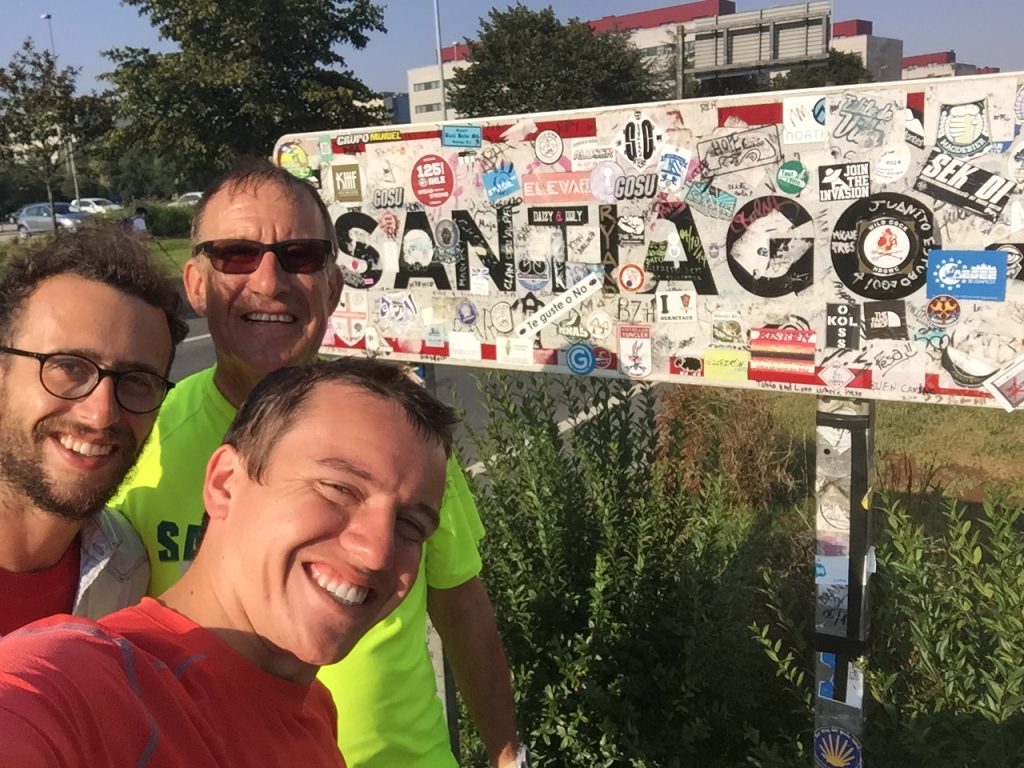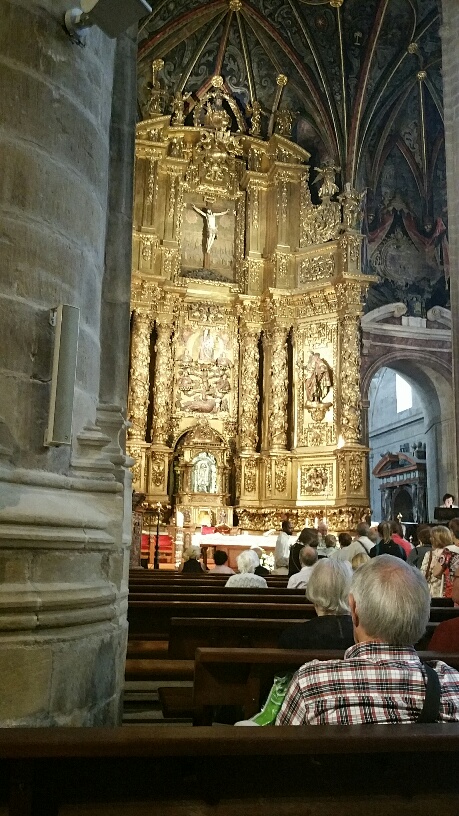July 19, 2017 // Local
Living the Camino de Santiago experience
Tom Labuzienski teaches a Camino de Santiago course at Forever Learning Institute, which is a 10-week class held at Little Flower Catholic Church in South Bend. Bishop Kevin Rhoades will discuss pilgrimages at the Oct. 25 session. To sign up for the class, visit foreverlearninginstitute.org.
God often operates through ordinary experiences in the lives of his children, who don’t always foresee how transformative those experiences will be in their lives. Such was the case for Tom Labuzienski and two of his grown sons, Andrew and Thomas, when, on a rare occasion, they sat down together and watched the movie “The Way.” The film depicts a father who embarks on a quest to recover his deceased son’s body from along the Camino de Santiago in Spain.

Tom Labuzienski, back, and his sons Andrew, left, and Thomas pause beside the sign outside the city of Santiago de Compostela, Spain, as they conclude their pilgrimage to the burial site of St. James.
Translated in English as “The Way of St. James,” the Camino is a number of trails that hiking and biking enthusiasts take throughout the Spanish countryside with the goal of ending at the cathedral in the city of Santiago de Compostela, where the remains of St. James are buried.
Labuzienski explained that the reason his and his sons’ Camino experience was so different from other pilgrimages he had taken is that it was truly a journey of surrender. “One can do the pilgrimage any way, but the most spiritual way is by surrendering to God’s way,” he said. “It’s the only place in the world where one can just start hiking alone, if the goal is to be more contemplative, or with others if one chooses to engage in conversation with other pilgrims.”
The reason thousands of Catholics worldwide flock to the Camino trails is that the experience immerses them entirely in nature, and removes them from the worldly distractions of maps, GPS systems, cell phones and other electronic devices. Those who embark on the Camino de Santiago choose to set aside time — a week, or perhaps a month or more — to encounter God without the emotional and spiritual clutter of material things.
“We made a hotel reservation in France upon our arrival to begin hiking the Camino, because we knew the area would be crowded with tourists in August,” Labuzienski said. “When we arrived we were told the hotel had no record of our reservation, and we were without a room. It was late at night, close to midnight, and we were exhausted. We felt like the Holy Family in Bethlehem, who had no place to rest their weary heads.”
But God provided for them. A French couple asked if the three men needed help, and they were generously given a place for them to stay overnight. Labuzienski realized immediately that God was in control of the pilgrimage, and that good could come from anything — including what may have otherwise been a disaster.
The Camino experience is unique, yet beautiful to each pilgrim. It is described by many as a way to watch God unfold in their lives in unpredictable but amazing ways. The adventure extends far beyond the mere path a pilgrim takes, which is often arduous.
“The journey forces a pilgrim to look at life more simply,” Labuzienski said.
Msgr. William Schooler, pastor at St. Pius X Parish, Granger, has also traveled the Camino. As a priest, his experience was different. “I did the Camino twice,” he said. “The first time was in 2007. I went with a group of cyclists, and because we didn’t have the luxury of taking an entire month out of our lives, we had to be ‘pilgrims lite.’” Those traveling with Msgr. Schooler had the blessing of praying morning and evening prayer, as well as attending daily Mass, because they had a priest accompanying them.
But it wasn’t until his second trip in 2009 that Msgr. Schooler truly experienced the spiritual aspect of the Camino, and in a profound way. “That time, I prepared booklets for the participants,” he explained. “After morning prayer, I would offer a reflection before we headed out for the day. In the evening, we would complete evening prayer, and I would celebrate Mass in one of the country parishes we found along the way.”
He and his group of pilgrims met up with about 20 members of the parish youth group during the last portion of the journey, walking as a larger group. “We developed a strong sense of community, facing some very difficult tensions and problems together, praying together and sharing meals together,” he said.
Part of the lure of the Camino is the spiritual renewal and meaningful connections made with other people along the way. “They are so helpful and gracious,” Labuzienski noted. Their charity reminded that most people “are truly good at heart.”

A sublime image of the cathedral in Santiago, Spain, where the remains of St. James are interred. Pilgrims to the site often choose to walk or ride for miles, across the countryside, on their way to the sacred site.
The sense of community has transferred into the way he lives his daily life, too. “I see people in a new light. God uses each of us as his instrument to help others in need.”
A common greeting among pilgrims is “Buen camino,” which means “Good journey.” That’s fitting, as pilgrims on the Camino de Santiago have chosen to set aside time for intentional living; and it provides a natural setting for holy conversations and deep personal prayer.
“Once you reach the cathedral in Santiago, you enter into Mass with incredible reverence,” Labuzienski said. “It’s a beautiful conclusion to this long, intense journey of hiking or biking: The arduous self-mortification leads to joy.”
“I’ve traveled the world,” Labuzienski remarked. “I’ve been on pilgrimages to the Holy Land, and spent a year at Loyola University’s Rome campus. Nothing compared to what I experienced on the Camino.”
The best news. Delivered to your inbox.
Subscribe to our mailing list today.






